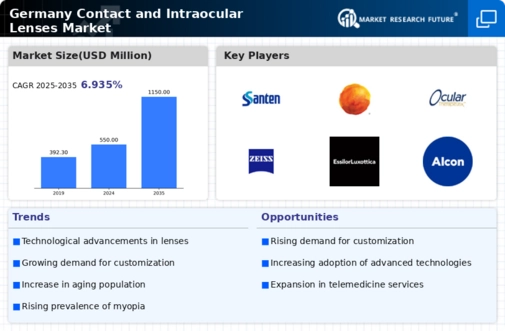Market Growth Projections
The Global Germany Contact and Intraocular Lenses Market Industry is poised for substantial growth, with projections indicating a market value of 4.5 USD Billion in 2024 and an anticipated rise to 7.2 USD Billion by 2035. This growth trajectory suggests a compound annual growth rate of 4.37% from 2025 to 2035, reflecting the increasing demand for innovative lens solutions. Factors such as the aging population, technological advancements, and rising awareness of eye health contribute to this positive outlook. The market's expansion is indicative of broader trends in healthcare and consumer preferences, positioning it for continued success.
Increase in Disposable Income
The increase in disposable income among the German population is a notable driver for the Global Germany Contact and Intraocular Lenses Market Industry. As individuals experience improved financial stability, they are more likely to invest in premium vision correction solutions. This trend is particularly evident in urban areas where consumers prioritize quality and comfort in their lens choices. The willingness to spend on advanced lens technologies contributes to market growth, as evidenced by the projected increase in market value to 7.2 USD Billion by 2035. This economic factor plays a crucial role in shaping consumer behavior and preferences.
Growing Awareness of Eye Health
Growing awareness of eye health among the German population significantly influences the Global Germany Contact and Intraocular Lenses Market Industry. Educational campaigns and initiatives by healthcare providers have led to increased screenings and consultations, prompting individuals to seek corrective lenses. This heightened awareness correlates with a surge in demand for both contact and intraocular lenses. As consumers become more informed about the options available, the market is poised for growth, with a projected compound annual growth rate of 4.37% from 2025 to 2035. This trend indicates a shift towards proactive eye care, further driving market expansion.
Expansion of Distribution Channels
The expansion of distribution channels is a critical driver for the Global Germany Contact and Intraocular Lenses Market Industry. With the rise of e-commerce and online retail platforms, consumers have greater access to a variety of lens options. This accessibility not only enhances consumer convenience but also fosters competition among suppliers, leading to better pricing and product offerings. As more retailers embrace digital platforms, the market is likely to witness accelerated growth. The projected market value of 4.5 USD Billion in 2024 reflects this trend, as consumers increasingly turn to online sources for their vision correction needs.
Rising Prevalence of Vision Disorders
The increasing prevalence of vision disorders in Germany is a primary driver for the Global Germany Contact and Intraocular Lenses Market Industry. As the population ages, conditions such as cataracts and myopia become more common, necessitating corrective solutions. In 2024, the market is projected to reach 4.5 USD Billion, reflecting the growing demand for both contact lenses and intraocular lenses. This trend is expected to continue, with the market anticipated to expand significantly as more individuals seek effective vision correction options. The aging demographic, coupled with lifestyle factors, underscores the urgency for innovative lens solutions.
Technological Advancements in Lens Design
Technological advancements in lens design are reshaping the Global Germany Contact and Intraocular Lenses Market Industry. Innovations such as multifocal and toric lenses enhance visual acuity and comfort, catering to diverse patient needs. These advancements not only improve the quality of life for users but also drive market growth. As manufacturers invest in research and development, the introduction of new materials and designs is likely to attract a broader consumer base. This trend is expected to contribute to the market's growth trajectory, with projections indicating a rise to 7.2 USD Billion by 2035, highlighting the importance of continuous innovation.






















Leave a Comment